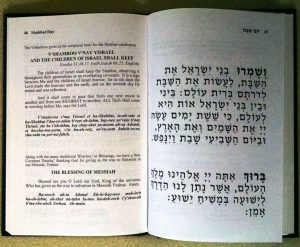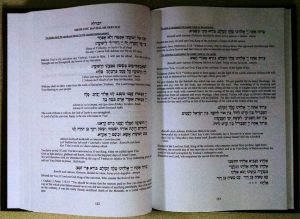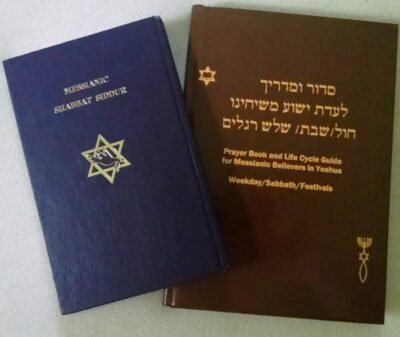A Siddur is a Hebrew book of blessings and prayers in a set order. The word comes from a root meaning “order,” the same place we get the word seder that describes the Passover celebration. The plural form in Hebrew is siddurim.
UPDATE- These two are sometimes difficult to find at a reasonable price. For another option, go here.
Siddurim are used both in public and in private worship. They come in various formats, including for Shabbat (Sabbath), for festival celebrations and for daily prayers. A printed edition may be intended for one or more of these. Structure and order is important in our worship of our Creator, and the Siddur is a tool to help us accomplish that. (Even though it is a Hebrew word, I won’t italicize it for the remainder of this post.)
To the chief Musician upon Nehiloth,
A Psalm of David.
Give ear to my words, O LORD, consider my meditation.
Hearken unto the voice of my cry, my King, and my God:
For unto thee will I pray.
My voice shalt thou hear in the morning, O LORD;
In the morning will I direct my prayer unto thee,
And will look up.
(Psalm 5:1-3, KJV)
A Traditional Siddur
Probably the most used Siddur today is The Complete Artscroll Siddur by Rabbi Nosson Scherman and published by Mesorah Publications Ltd. This is an exhaustive book with over 1000 pages of blessings, prayers and Scripture readings in both Hebrew and English. But for many of us, it is sadly lacking on one thing: It does not acknowledge Yeshua as the Messiah.
For the Messianic believer in Yeshua, the traditional Siddur is a good starting point but is incomplete. So, here are two editions of the Siddur for you to consider that keep the beauty of Jewish traditions while recognizing that Yeshua is the promised Messiah, the Redeemer of Israel and Savior of the world. They are very different in their layout and presentation. I hope that one or both of these will be useful for you in your worship.
Messianic Shabbat Siddur
Author: Jeremiah Greenburg
Messianic Liturgical Resources
140 pages, hardcover
No ISBN available
This is a great Siddur that follows the traditional layout for a Hebrew book. Looking at the front cover, the spine is on the right. You open the book from the left-hand side, and turn the pages the same way as you read toward the back of the book. Think exactly the opposite of a textbook you would buy in a western bookstore.

Each two-page spread has the Hebrew in a comfortably large font on the right-hand page, with the English translation and corresponding transliteration of the Hebrew on the facing (left-hand) page. Occasionally the author will add an explanatory note in English when needed.
Following one of the common traditions, the Divine Name (yod-hey-vav-hey) is shown as a double yod in the Hebrew text. In the transliterated text, Adonai is used and in the English translation it says “The Lord.”
The sections are well labeled. After a few introductory pages, you come to Erev Shabbat, or Sabbath Evening, a time to welcome the beginning of Shabbat in the home. To show you how this differs from the Artscroll Siddur, Here is an example of how the Messianic Shabbat Siddur includes Yeshua in this sacred, set-apart time:
From the Artscroll Siddur:
Over the Sabbath Lights
Blessed are You, HASHEM our God, King of the Universe, Who has sanctified us with His commandments, and has commanded us to kindle the light of the Sabbath.
(Note that there is no Biblical command to light Sabbath candles – it is simply a tradition.)
From the Messianic Shabbat Siddur:
Candle Lighting Prayer
Blessed are You, O Lord our God, King of the Universe; Who has sanctified us in Your Word and given us Yeshua our Messiah, and commanded us to be a light to the world. Amen
Following the Erev Shabbat section for beginning the Sabbath there is a complete section for the Shabbat Evening Service. It incorporates many of the traditional blessings and prayers along with the Blessing of the Messiah, concluding with the Kiddush – blessing over wine and bread – and the Aaronic Benediction.
There is also a complete Shabbat Morning Service, Torah Service and Concluding Prayers. Some of these are the same as in the Shabbat Evening Service, but they are printed again here so that moving through the Siddur is simple and orderly.
This Siddur is primarily for the Sabbath, but there is a section marked Additional Worship which includes many of the daily blessings and prayers, Scripture readings and more suggestions for worship in the home.
This is an ideal resource for corporate congregational worship, but is also very useful if you have no congregation you can meet with and are looking for a guide to keep Sabbath in your home. The author, Jeremiah Greenburg, has recorded the entire Siddur and made it available on two CDs, so you can listen to the Hebrew read and often chanted as you learn these prayers.

 Prayer Book and Life Cycle Guide for Messianic Believers in Yeshua,
Prayer Book and Life Cycle Guide for Messianic Believers in Yeshua,
Weekday/Sabbath/Festivals
Author: Messianic Rabbi/Pastor William A. Berg
AZB Messianic Liturgical Resources
228 pages, hardcover
ISBN: 978-159858-964-1
Unlike the Artscroll Siddur and Messianic Shabbat Siddur, this book has a traditional western layout. Looking at the front cover, the spine is on the left, and you open it just as any other western textbook. Each blessing or prayer is printed in sequence, first in Hebrew, then transliterated Hebrew, then in English. Like the Messianic Shabbat Siddur, the Divine Name is shown as a double yod in the Hebrew text. In the transliterated text it reads Adonay and in the English translation it says The Lord.

This is more a complete Siddur rather than just for Sabbath. There is a section with prayers and blessings for each of these specified times in the day:
Messianic Shacharit (weekday morning)
Messianic Mincha (weekday afternoon)
Messianic Ma’ariv (weekday evening)
There are also sections for:
Messianic Evening Service – Shabbat and Festivals
Messianic Shacharit Service – Shabbat and Festivals
Everything is designed for the Messianic believer in Yeshua while observing many of the traditions. When traditional prayers are adapted for each Biblical festival, the differences are all noted together for each prayer. This is very easy to follow and especially easy to see what changes have been made.
Looking again at the prayer for candle lighting, here is what you will find in the Prayer Book and Life Cycle Guide for Messianic Believers in Yeshua:
Blessed are You, O Lord our God, King of the Universe, Who has justified us through faith in Yeshua the Messiah, the Light of the world, and in His Name we kindle the Sabbath (Festival) (Shabbat and Festival) lights.
Finally, there is a section marked as Messianic Life Cycle Madrik (“guide”, from the word derek meaning “walk”). Here you will find things like grace after meals, customary prayers for naming a child, for circumcision, for bar– and bat-mitzvah and more. There is even a Messianic Wedding Ceremony and a Funeral and Burial Service.
Many of the traditional blessing have been modified to include Yeshua or Messianic references. For example, part of the Avot (Forefathers) portion of the Amidah reads, in English,
“…who remembers the loyal deeds of our ancestors and in love has brought Yeshua the Redeemer to their children’s children for His Name’s sake.”
The traditional wording is,
“…who recalls the kindnesses of the Patriarchs and brings a redeemer to their children’s children, for His Name’s sake, with love.”
In fact, the Hebrew and Hebrew transliteration are the traditional rendering; only the English makes the reference to Yeshua. There are many instances in this Siddur where the English contains additional wording not found in the Hebrew or Hebrew transliteration, and it appears that in most of those cases the Hebrew matches the traditional Siddur. Still, this is an excellent prayer guide for believers in Yeshua.
These two Siddurim are great tools to use as you worship our Father. I have collected a few of blessings and prayers in the Liturgy section of my web site, MessianicTorahPortion.com, but there is something special about holding and looking at a real, bound Siddur.
UPDATE – If these are unavailable or unreasonably priced, another option can be found here.




Both of these books are very expensive or unavailable on Amazon. Do you know why?
Shalom, I wrote this post back in 2018 and at that time both of these were available and reasonably priced. Since that time things have changed. For an excellent Shabbat Siddur, check out this one: Messianic Siddur for Shabbat. You might also keep an eye on these items as the availability and price fluctuates.
I need to find a siddur in Spanish and Hebrew. Is there one available by Jeremiah Greenberg?
Greenberg’s siddur was available in Spanish at one time, but you should contact him directly to see if he still has it. Contact me at larry@messianiclight.com and I will give you his email address. You might also find this book Servicio Mesiánico de Shabbat by Dr. Hollisa Alewine (written in English and translated into Spanish) helpful.